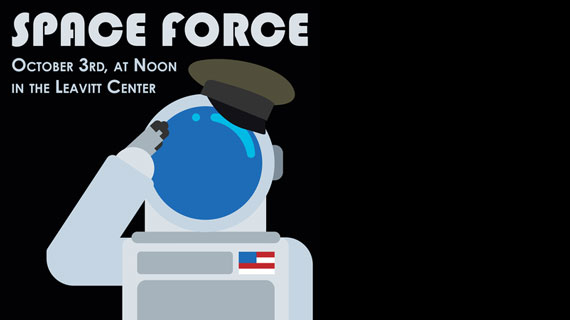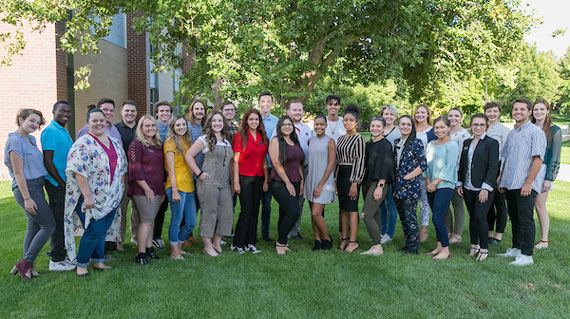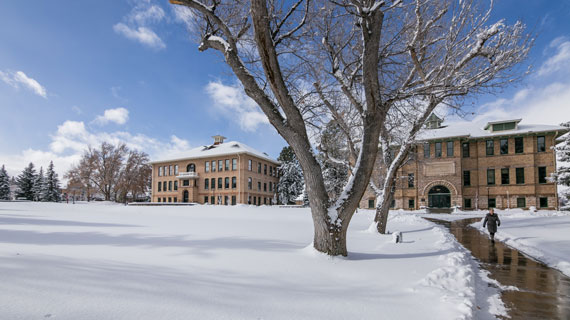Pizza and Politics - Discussing Space Force
Posted: October 03, 2018 | Author: Cami Mathews | Read Time: 4 minutes
 The Michael O. Leavitt Center for Politics and Public Service hosts Pizza & Politics every Wednesday at noon to discuss a current political topic. Leavitt Center student employees research the topic and moderate the conversation. These discussions expose students to a variety of important issues and encourages them to share their own perspectives while learning all sides of an issue. Free pizza is provided for all who attend.
The Michael O. Leavitt Center for Politics and Public Service hosts Pizza & Politics every Wednesday at noon to discuss a current political topic. Leavitt Center student employees research the topic and moderate the conversation. These discussions expose students to a variety of important issues and encourages them to share their own perspectives while learning all sides of an issue. Free pizza is provided for all who attend.
Earlier in the year, students voted on their favorite topics that they wanted to see at Pizza & Politics. Space Force received a large number of votes, ranking in the top five. The Leavitt Center Executive Council members Taylor Cella and Logan Platt moderated the discussion. Taylor is a senior Information Systems major with a minor in Computer Science from Syracuse, Utah. Logan is a senior majoring in Biology with a minor in Outdoor Recreation and Sustainability from South Ogden, Utah.
Space Force was first proposed by President Donald Trump, followed by Vice President Pence who said it would be established by 2020. The branch of the military would need at least 13,000 personnel and cost an estimated $13 billion over the first five years.
The first steps for creating Space Force is to start a new U.S. Space Command to unify leadership and ensure a smooth military integration. There also needs to be the creation of a Space Development Agency to focus on research, advance space technologies, and improve “war-fighting capabilities.”
Secretary of Defense Mattis said Space Force will also focus on cyberspace and cybersecurity. The Air Force currently executes 90% of military space operations through the Air Force Space Command. The White House proposed a separate U.S. Space Command Center which would pull space experts from across the armed services. They would also have a separate acquisitions office dedicated to buying satellites and developing new technology to “help the military win wars in space.”
As far as the main priority of Space Force, there really isn’t one. Some students in the discussion said Space Force was unnecessary and a giant waste of time. Others felt that space is the next frontier and the U.S. needs to be prepared for attacks by other countries.
In June, President Trump said, “we must have American dominance in space.” Air Force Secretary Heather Wilson said, “we’re the best in the world at space. Our adversaries know it and they’re developing the capabilities to deny us the use of space in crisis or war and we are determined that not be allowed to happen.”
Reports have shown that Russia and China have tested anti-satellite technology and are actively pursuing hypersonic weapons. Russia has a hypersonic glide vehicle that could navigate its way through space after launch without any human guidance or interaction. In 2015, China was in the process of developing anti-satellite systems that could potentially target U.S. space assets.
When asked about a military presence in space, students were conflicted. If the reports are true, then the U.S. needs to defend itself from its enemies. If the reports aren’t true, the country will have spent billions on unnecessary precautions. The audience did agree that Russia and China are threats, but were unsure if an attack on them would be through space.
As stated earlier, estimates say Space Force will cost $13 billion over five years. The Pentagon has not release official numbers and the estimates are said to be conservative. Recently, the military requested a budget of $686 billion for the 2019 fiscal year, which was approved and an $80 billion increase from the 2017 budget.
Funding for Space Force could come from a few different sources. Only a couple of students said more money should be given to the military, specifically to Space Force. Many students felt the budget to the Air Force could get cut and moved to the new branch. One student suggested that Disney pay for it through the profits from Star Wars Land and other Star Wars merchandise.
There is currently an Outer Space Treaty of 1967 that regulates space - kind of. It came about after the Russian launch of SPUTNIK. It established several broad principles to guide space exploration, including:
- The exploration and use of outer space shall benefit all of mankind
- Outer space and celestial bodies are free for exploration and use by all
- No weapons of mass destruction are permitted in outer space
- The moon and other celestial bodies can only be used for peaceful purposes
- Outer space and celestial bodies cannot be claimed by national entities
Outer space is like the ocean, an open resource for everyone. Students did not think that space should be claimed by countries and divided like the world. All plans for Space Force would go against the Outer Space Treaty, making some students believe the United Nations or other international group would soon be making changes.
A fun conversation at times, the audience realized that Space Force is happening and it is the future of the world. The money will need to come from somewhere, the treaty will need to be updated, and people will need to get ready for the new frontier.
For more information on the Leavitt Center, visit their webpage.
This article was published more than 3 years ago and might contain outdated information or broken links. As a result, its accuracy cannot be guaranteed.
Tags: Student Leavitt Center



